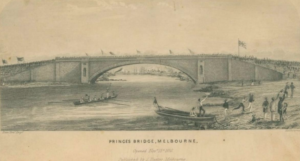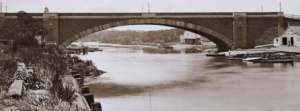The Princes Bridge – a prominent landmark located in central Melbourne – is the city’s grandest and oldest bridge.
Princes Bridge is built on the site of one of the oldest river crossings in the nation, connecting two of the city’s major thoroughfares, Swanston Street and St Kilda Road. The bridge is 30 metres wide and 131 metres long and is styled on Blackfriars Bridge which crosses over the River Thames in London. However, while Blackfriars Bridge has 5 spans, Princes Bridge is somewhat shorter and has only three spans, each of 33 metres.
Naming of Princes Bridge
Princes Bridge is named in honour of the Prince of Wales, later King Edward Vll. From 22 January 1901 until his death in 1920, Edward Vll was the king of the United Kingdom of Great Britain, Ireland, the British Dominions and Emperor of India. The bridge was given its name by Victorian Governor Charles La Trobe during the foundation-laying ceremony. La Trobe was appointed superintendent of the Port Philips District of New South Wales, in 1839.
After the establishment of the colony Victoria, he became Victoria’s first lieutenant-governor in 1851. Many of Melbourne’s inner-ring gardens and parks can be attributed to La Trobe’s foresight in determining that this land be reserved. In Melbourne and throughout Victoria, you can find numerous landmarks named in honour of La Trobe, including La Trobe University and La Trobe Street in Melbourne’s CBD.
The current Princes Bridge is the third bridge built at this location. The first two bridges were built in response to a population explosion caused by the Gold Rush.
Prior to the construction of the bridge, punts were used to transport people and animals across the river. Melbourne’s first punt was operated by William Watt from 1838 and was described as a ‘dray without wheels… launched through the agency of a small rope looped round the main rope across the river’. Numerous other punts provided access across the river in the early 1840s.
The first bridge
In 1840 a company was formed in order to construct a bridge, as the government in Sydney had proven unreliable when it came to providing funds. In 1945, a timber bridge – known as Balbirnie’s Bridge – was built across the river. A toll was charged by the lease-holder, Robert Balbirnie, with the toll house located on the north bank of the river. The toll-keeper, Patrick Doherty, was credited with saving nine lives during his four-year period of employment.
Shortly after the completion of the timber bridge, authorities decided that a more robust solution was required and that the timber bridge should be replaced by a stone bridge.
The second bridge
The second bridge was designed by David Lennox and built by James Linacre. David Lennox was a bridge builder from Scotland, who moved to Australia in 1832 and to Victoria in 1844. Over an eleven-year period Lennox was responsible for the construction of fifty-three bridges throughout Victoria. The cornerstone was laid on 20th March 1846 and the bridge was opened in November 1850. The opening of the second bridge was cause for real celebration, as it’s completion coincided with the point at which Victoria was about to become a separate colony.
Unfortunately, the design of the second (Lennox) bridge made it difficult for flood waters to pass and Melbourne’s rapidly growing population called for a new bridge. Gold was discovered in Victoria in 1851, just a year after the second bridge was opened. The gold rush produced extraordinary wealth which in turn led to dramatic increase in Victoria’s population. The increased population and economic activity led to increased shipping traffic on the Yarra River, and a new bridge was required in order to accommodate the widening of the river and to handle the massive increase in traffic crossing the bridge.
The third (and current) bridge
After the decision had been made to replace the second bridge, in 1879 a contest was held to find a design for the new bridge. The competition was won by architect John Grainger, who entered in partnership with a local architect, Mr. Jenkins. John Grainger designed 14 bridges and numerous notable buildings in both Australia and New Zealand.
The second bridge was not dismantled until 1884, due to problems with funding and other issues. Construction commenced on the third (and current) bridge in 1886 and was completed in 1888, just in time for the second International Exhibition that was held in Melbourne.
The bridge is adorned with the coat of arms belonging to the municipal councils who contributed towards the cost of the bridge’s construction. An elaborate balustrade runs along the top of the bridge, and lamp standards crown each pier.
Historical significance
Princes Bridge is listed on the Victorian Heritage Register, because of its historical significance. The bridge had an important role in the early establishment of main roads around and in the city. The main streets, particularly river crossings had a huge influence in forming the shape of the city. The bridge had a significant role in linking port, recreational and industrial facilities with the city centre. This facilitated the demographic and economic development of Melbourne.
Additionally, the bridge is also of social and aesthetic significance. It is Melbourne’s grandest and oldest bridge, which makes it a prominent landmark. The Princes Bridge is a symbolic entrance to the city of Melbourne and lies on the main axis of St Kilda Road, the Shrine of Remembrance and Swanston Street.
The Princes Bridge is also of architectural significance for its size and skilled craftsmanship. The bridge has a lot of architectural details for example on the arched girders. The bridge represents the builds of contractor David Munro, who was also responsible for the build of the Queens bridge and Sandridge Railway Bridge. David Munro (1844 – 1898) was a Scottish engineer, contractor and speculator.
Users of the bridge today
Pedestrians account for most of the traffic over the bridge. However, other forms of traffic are also seen on the bridge such as trams, busses, motor vehicles and bicycles. The pedestrian traffic is two ways, with many of them visiting the Melbourne Arts Precinct or commuters parking at the Arts Centre and going to work in the CBD.
Melbourne landmarks located close to Princes Bridge
The Melbourne Arts Centre is located close to the Princes Bridge. The Arts Centre is a cultural and architectural landmark in Melbourne. It is Australia’s busiest and biggest performing arts venue, staging more than 4,400 events and performances every year. The Melbourne Arts Centre is a partner and host to national companies such as Opera Australia, Australian Ballet, Australian Chamber Orchestra and more. Other places can be visited as well for example the Sunday Crafts market, daily guided tours and the Australian Music Vault.
Celebratory events are often held at Princes Bridge, due to its location. Moomba Festival, New Year’s Eve and many other celebrations take place on the Yarra River. The bridge most recently underwent a restoration in the lead up to the 2006 Commonwealth Games.
To learn more about Melbourne and the surrounding areas, take a tour with Go West!
Written by Jessica Senden: Marketing Intern @gowest.com.au






